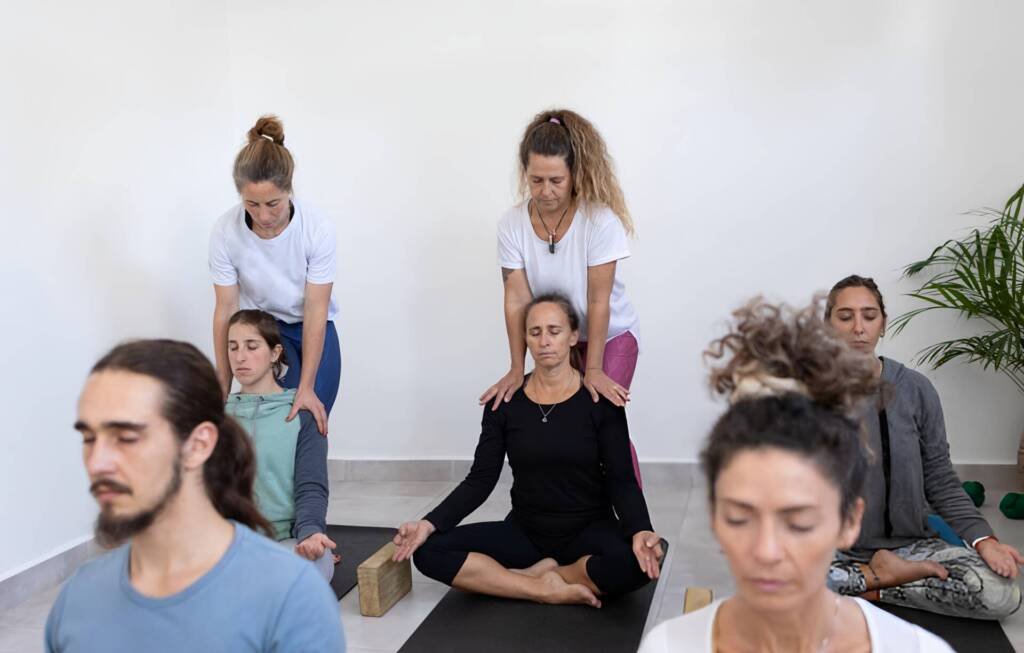Teaching meditation is a deeply rewarding practice, but it’s not without its challenges. It requires patience, skill, and self-awareness—not just to lead sessions effectively but to nurture a safe, inclusive, and engaging environment for students. Even seasoned meditation instructors can face unique hurdles, like guiding restless groups or managing skepticism.
Table of Contents
You’re not alone if you’ve encountered obstacles in your meditation teaching journey. This blog dives into ten common challenges in teaching meditation and provides actionable strategies to overcome them. Whether you’re new to teaching or looking to refine your skills, you’ll leave with tools to address these obstacles with confidence.
1. Guiding Distracted or Restless Groups

The Challenge:
When teaching group meditation, it’s common to encounter participants who fidget, check their phones, or can’t sit still. This can disrupt the class and distract others from focusing.
The Solution:
- Start with short meditations and gradually increase the duration as the group becomes more accustomed to sitting still.
- Incorporate mindfulness exercises to help the group settle into the present moment. For example, begin with a few minutes of mindful breathing or a body scan to draw their attention inward.
- Use curiosity as an anchor by softly guiding participants to “notice the fidget” or “observe restlessness.” Redirecting awareness to the body can transform distractions into opportunities for mindfulness.
Example: One teacher shared how they introduced simple grounding exercises—like feeling the floor beneath their feet—which helped one group go from restless to mindful in just three sessions.
2. Addressing Skepticism in the Room

The Challenge:
Some participants, especially beginners, can approach meditation with doubt or skepticism about its benefits. This resistance may create a barrier to their participation.
The Solution:
- Highlight the evidence-based benefits of meditation, such as stress reduction and improved focus. Sharing studies can help skeptics feel more confident about its effectiveness.
- Share personal or relatable stories about how meditation has positively impacted your life or others. Stories can make the practice feel more approachable.
- Welcome skepticism with a non-judgmental attitude. Encourage participants to adopt a “curious mindset” and see what happens through their own experience.
Resource Tip: To strengthen your credibility, keep reputable studies handy, such as research from institutions like Harvard or Stanford.
3. Dealing with Overly Talkative Participants

The Challenge:
Every instructor has likely encountered that one participant who dominates discussions, making it difficult for others to contribute or for the class to stay on track.
The Solution:
- Set clear boundaries at the start. For instance, explain that discussions will have time limits to ensure everyone has a chance to speak.
- Use a “talking stick” technique to give each participant a set time to share. This establishes fairness and order.
- If necessary, politely redirect a talkative participant by thanking them for their enthusiasm and inviting others to share their perspectives.
4. Handling Your Own Doubts as a Teacher

The Challenge:
Even experienced meditation instructors face moments of self-doubt. Questions like “Am I good enough?” or “Did I guide that session properly?” can cloud your confidence.
The Solution:
- Focus on your unique teaching style. There’s no one-size-fits-all approach to meditation—your authenticity is what makes you effective.
- Practice self-compassion and use moments of self-doubt as opportunities to learn and grow.
- Deepen your personal meditation practice. Regular practice will keep you grounded and strengthen your confidence in teaching.
Remember, every teacher experiences doubt—it’s part of growth.
5. Teaching Meditation to Beginners

The Challenge:
Teaching beginners can be tricky. Overcomplicating concepts overwhelms them, while oversimplifying may leave them disengaged.
The Solution:
- Start with basic breathwork exercises, as they’re simple yet effective.
- Use relatable metaphors to explain concepts. For instance, describe thoughts as passing clouds to illustrate mindfulness.
- Focus on one technique at a time to prevent overwhelming newcomers.
Beginner-friendly sessions often lead to participants who feel inspired and confident to continue their practice.
6. Managing Cultural Sensitivity and Inclusivity
The Challenge:
Meditation has roots in various cultural traditions and teaching respectfully and inclusively is essential.
The Solution:
- Avoid using culturally appropriative language, symbols, or practices without proper context and explanation. For example, if referencing Buddhist concepts, provide a respectful, accurate background.
- Stay open to receiving feedback and tailor your sessions to reflect participants’ unique cultural contexts.
- Use inclusive language and ensure that your approach feels welcoming to people of all backgrounds.
Mindful inclusivity deepens trust and connection with your group.
7. Adapting Meditation Practices for Virtual Settings

The Challenge:
Online teaching presents unique difficulties, such as technical glitches or trouble creating a sense of connection.
The Solution:
- Ensure clear audio and minimal distractions are present in your setup. Even minor improvements in sound quality can transform the experience.
- Encourage participants to turn on their cameras (if they’re comfortable) to foster a sense of community.
- Create engaging rituals to mark the start and end of a session, such as inviting participants to light a candle or share a single word that describes their current state.
8. Facing Resistance to Meditation Practices

The Challenge:
Some participants may struggle with or feel discomfort during specific techniques, leading to resistance.
The Solution:
- Offer alternative practices to accommodate different preferences. For instance, replace silent meditation with a guided visualization.
- Keep techniques short and accessible. Breaking sessions into smaller chunks can ease frustration.
- Ensure participants feel free to opt-out if something doesn’t resonate with them. Respect their individual needs.
9. Balancing Personal Energy While Teaching

The Challenge:
Teaching multiple sessions or holding space for large groups can be physically and emotionally draining.
The Solution:
- Build rest into your schedule. Scheduling downtime prevents burnout.
- Incorporate energy-replenishing practices like yoga, breathwork, or mindful walking between sessions.
- Set boundaries to protect your energy—both personal (e.g., limiting phone use) and professional (e.g., creating precise email response hours).
10. Keeping Meditations Engaging and Fresh

The Challenge:
Repetition can sometimes make meditations feel stale, both for instructors and participants.
The Solution:
- Experiment with themed meditation sessions (e.g., gratitude, relaxation, or creativity).
- Use visualization exercises to add variety. For example, guide participants on a nature-inspired visualization.
- Incorporate sensory elements, like soft music or nature sounds, to enhance experiences.
Your creativity can help inspire and engage participants, leaving them excited to return for more.
Turn Challenges into Opportunities for Growth

Teaching meditation is a practice of mindfulness in itself—it’s an opportunity to grow both as an instructor and as an individual. Challenges like managing distracted groups or addressing skepticism may test your patience, but they also deepen your resilience and connection with students.
Have you experienced any of these challenges in your teaching practice? Share your thoughts in the comments or reach out—we’d love to hear from you.
Subscribe to our newsletter for more resources and tips on teaching meditation. Together, we can make meditation even more accessible and impactful for everyone.





